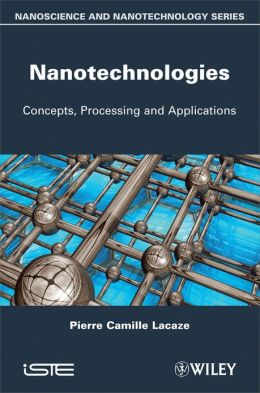 [内容简介]
[内容简介]
Nanotechnologies: Concepts, Processing and Applications describes and explains how nanotechnologies have entered our everyday lives through scientific and industrial applications with the emphasis placed on the new perspectives in various fields related to societal problems. This book details how successive discoveries of new nanocarbon structures along with progress in different microscopy techniques have caused nanomaterials to take on an increasingly important role in electronics, electrochemical energy storage – batteries and fuel cells – and the electrical conversion of solar energy. Views once seen as futuristic on nanomachines and nanorobotics, therapeutic hopes and medical advances – such as those resulting from the application of new in-situ drug-delivery nanotechniques – are all presented.
The most innovative developments are analyzed in terms of applications and should enable the reader to form his or her own opinion about the reality of the progress that can be expected from nanotechnologies in the near future. The book offers background reading for teachers in colleges who wish to have an overview on this subject.
[目次]
Part I. Concepts, discoveries and the rapid development of nanotechnologies
Chapter 1. Nanotechnologies in context: Social and scientific awareness of the impact of nanotechnologies
1.1 Feynman, the visionary
1.2. Nanotechnologies and their definition
1.3. The consideration of nanotechnologies by scientific organizations
1.4. References
Chapter 2. The rapid expansion of nanotechnology. New ways of observing the infinitesimal and the discovery of carbonaceous nanomaterials with unusual properties
2.1. Improving tools for observing the infinitesimal
2.1.1. Transmission Electron microscopes (TEM)
2.1.2. Scanning Electron Microscopes (SEM)
2.1.3. Near-field microscopes
2.2. The discovery of new carbonaceous nanomaterials
2.2.1. Some basic concepts relative to the electronic structure of carbon and to the bonding rules between carbon atoms
2.2.2. The fullerenes or graphite sheets rolled into a ball
2.2.3. Carbon Nanotubes (CNT): tubes of graphite sheets
2.2.4. Graphene or graphite “sheets”
2.2.5. Link between conjugated carbonaceous nanomaterials
2.3. Conclusions
2.4. References
Chapter 3. Nano- materials in all their forms. New properties due to the confinement of matter
3.1. The different types of nano-objects: main methods of preparation
3.1.1. Colloidal solutions of gold NPs
3.1.2. Hybrid and magnetic NPs (ferromagnetic fluids)
3.1.3. Semiconducting NPs (Quantum Dots)
3.1.4. Phospholipid vesicles and encapsulation by liposomes
3.1.5. Nanowires (NWs)
3.2. Organizing nanoparticles and molecules into arrays
3.2.1. The principle of self-assembly
3.2.1.1. Molecular self-assembly and the formation of nanometric networks
3.2.1.2. Self-assembly of NPs on solid surfaces
3.2.2. Assembling by ultrathin alumina membranes
3.2.3. Assembling by colloidal lithography
3.3. Conclusions
3.4. References
Chapter 4. Some amazing properties of nanomaterials and of their assembly into networks
4.1. The first effect of the confinement of matter: unusual catalytic and physico-chemical properties
4.2. The opto-electronic properties of NPs due to confinement
4.2.1. Some concepts of physics that can be applied to solid materials
4.2.2. The Plasmon resonance effect and the optical properties of gold NPs
4.2.3. Surface Enhanced Raman Scattering (SERS)
4.2.4. The photo-thermic effect or how to heat up gold NPs
4.3. The optoelectronic properties of Quantum Dots (QDots)
4.4. The amazing properties of NP networks or nano-structured surfaces
4.4.1. Wettability of structured surfaces
4.4.2. Optical properties
4.4.3. Nanoelectronics applied to the detection of trace elements: nanowire transistors
4.5. Conclusions and perspectives
4.6. References
Part II Applications and societal implications of nanotechnologies.
Chapter 5 Nanoelectronics of the 21st century
5.1. Some history
5.2. Molecular electronics
5.2.1. Single Electronics. Dream or reality?
5.2.3. The ultimate step: the molecule
5.2.4. Conclusion
5.3. Spintronics
5.3.1. Electron spin and ferromagnetic materials
5.3.2. Magnetoresistance
5.3.3. Giant MagnetoResistance (GMR)
5.4. Conclusions
5.5. References
Chapter 6. Energy and nanomaterials
6.1. Electrochemical storage of electricity
6.1.1. Electrical properties of an accumulator
6.1.2. Lithium batteries
6.1.3. Electrochemical capacitors and supercapacitors
6.1.4. Conclusions
6.2. The conversion of solar energy into electrical energy
6.2.1. The principle of the conversion
6.2.2. The inorganic route based on mineral semi-conductors
6.2.3. The organic route
6.3. Fuel cells
6.3.1. Working principle of PEMFCs (proton exchange membrane fuel cells)
6.3.2. Can the cost of dihydrogen fuel cells be reduced?
6.4. General conclusions
6.5. References
Chapter 7. Nanobiology and nanomedecine
7.1. Introduction
7.2. Bionanoelectronics: a new way of joining the world of the living with the outside
7.2.1. The multiplexed detection of PSA using "transistorized" nanowires.
7.2.2. Bionanoelectronics: connecting the living and the artificial
7.3. Nanomedicine
7.3.1. Biological barriers and the alteration of the cellular tissue surrounding a tumor
7.3.2. Nanoprobes for in vivo real-time imaging
7.3.3. Challenges of nanomedicine and some significant clinical results
7.3.4. Problems related to toxicity of nanomaterials
7.4. Conclusions and perspectives
7.5. References
Chapter 8. Nanorobotics and nanomachines of the future
8.1. Natural molecular machines
8.1.1. ATP-synthase
8.1.2. Myosin: a linear protein nanomotor
8.2. Artificial molecular machines
8.2.1. Artificial molecular machines in solution
8.2.2. Nanomachines with mechanical properties
8.3. Conclusions
8.4. References

 新书报道
新书报道